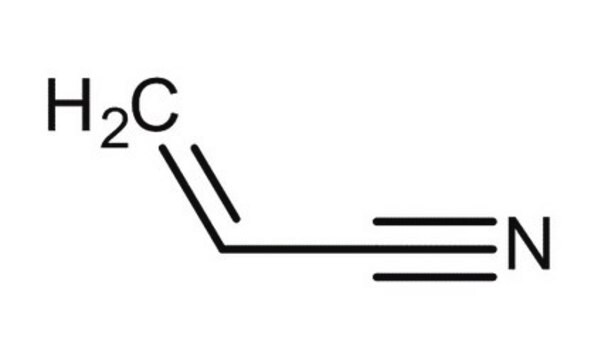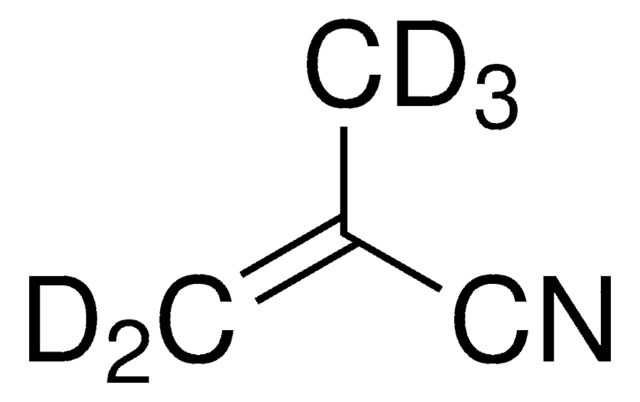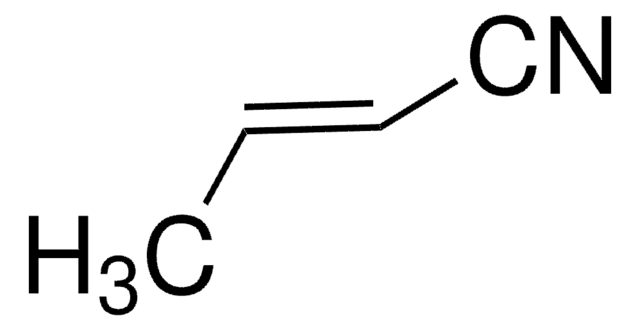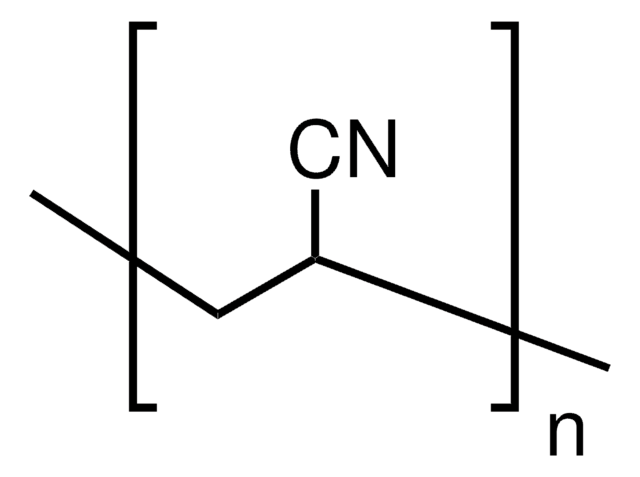推薦產品
蒸汽密度
1.83 (vs air)
品質等級
蒸汽壓力
86 mmHg ( 20 °C)
化驗
≥99%
自燃溫度
897 °F
包含
35-45 ppm monomethyl ether hydroquinone as inhibitor
expl. lim.
17 %
折射率
n20/D 1.391 (lit.)
bp
77 °C (lit.)
mp
−83 °C (lit.)
SMILES 字串
C=CC#N
InChI
1S/C3H3N/c1-2-3-4/h2H,1H2
InChI 密鑰
NLHHRLWOUZZQLW-UHFFFAOYSA-N
尋找類似的產品? 前往 產品比較指南
一般說明
丙烯腈常用作单体,属于不饱和腈类。它可用作生产具有良好性质的各种聚合物和共聚物的关键单体。丙烯腈常用于生产丙烯酸纤维,这种纤维以柔软性、强度和良好的耐热性和耐化学品性而著称。丙烯腈的主要应用领域之一是丙烯腈-丁二烯-苯乙烯(ABS)共聚物的制造。ABS是一种耐用的多功能塑料,广泛应用于汽车部件、设备、电器外壳和消费品。丙烯腈的加入提高了共聚物的耐热性和冲击强度,从而使ABS成为一种备受青睐的材料。
應用
丙烯腈可用于制造丙烯酸纤维、树脂(丙烯腈-丁二烯-苯乙烯、苯乙烯-丙烯腈等)以及丁腈橡胶(丁二烯-丙烯腈)。
丙烯腈可用作单体:
- 用于制备3D打印聚合物材料丙烯腈-丁二烯-苯乙烯(ABS),其是一种常用的工程热塑性塑料,以高强度、耐用性和耐热性而著称。它可用作各种应用(包括医学领域、相容的制造过程、注射成型、吹塑成型和挤出)中的合适基质。
- 与木素磺酸盐共聚以开发碳纤维前体。该共聚物可用作前体材料,经过进一步的热处理后可生成碳纤维。
- 用于合成丙烯酰胺接枝丙烯腈共聚物膜,该共聚物膜可用作细胞酶固定的支撑基质(support matrix )。
生化/生理作用
属工业致癌物,对大鼠具有多位点致癌性,也可能对人体具有致癌性。
訊號詞
Danger
危險分類
Acute Tox. 3 Dermal - Acute Tox. 3 Inhalation - Acute Tox. 3 Oral - Aquatic Chronic 2 - Carc. 1B - Eye Dam. 1 - Flam. Liq. 2 - Skin Irrit. 2 - Skin Sens. 1B - STOT SE 3
標靶器官
Respiratory system
儲存類別代碼
3 - Flammable liquids
水污染物質分類(WGK)
WGK 3
閃點(°F)
23.0 °F - closed cup
閃點(°C)
-5 °C - closed cup
個人防護裝備
Faceshields, Gloves, Goggles, type ABEK (EN14387) respirator filter
客戶也查看了
R A Woutersen
Scandinavian journal of work, environment & health, 24 Suppl 2, 5-9 (1998-08-26)
Acrylonitrile is a monomer used extensively as a raw material in the manufacturing of acrylic fibers, plastics, synthetic rubbers, and acrylamide. It has been classified as a probable human carcinogen according to the results of numerous chronic rat bioassays. The
R Thier et al.
Archives of toxicology, 74(4-5), 184-189 (2000-08-26)
The high acute toxicity of acrylonitrile may be a result of its intrinsic biological reactivity or of its metabolite cyanide. Intravenous N-acetylcysteine has been recommended for treatment of accidental intoxications in acrylonitrile workers, but such recommendations vary internationally. Acrylonitrile is
N A Esmen
Scandinavian journal of work, environment & health, 24 Suppl 2, 63-70 (1998-08-26)
The reconstruction of worker exposures has been the mainstay of modem industrial epidemiologic studies. In most cases, the researchers are faced with the difficult dilemma created by the scarcity of the exposure measurement data vis-à-vis the demands for refined quantification.
Acrylonitrile and human cancer--an overview.
D Coggon et al.
Scandinavian journal of work, environment & health, 24 Suppl 2, 81-82 (1998-08-26)
J Whysner et al.
Regulatory toxicology and pharmacology : RTP, 27(3), 217-239 (1998-08-07)
Acrylonitrile (ACN) exposure is associated with tumors in rat brain, Zymbal gland, and mammary gland. Adducts affecting base pairing were formed in isolated DNA exposed in vitro to the ACN metabolite cyanoethylene oxide (CNEO). DNA from liver, which is not
我們的科學家團隊在所有研究領域都有豐富的經驗,包括生命科學、材料科學、化學合成、色譜、分析等.
聯絡技術服務
















